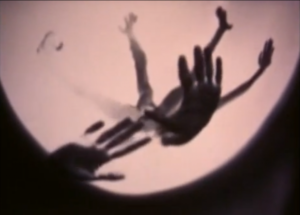October, of course, is haunting season. Our next program is anchored by films that we’ve seen that stick with us over time, preoccupying us with their mystery and power, occasionally jumping into our head to poke at us. Over the first few years of Full Aperture – our ongoing series highlighting experimental and artist film – early experimental filmmakers like Oskar Fischinger and Len Lye have been some of our audience favorites, with viewers talking about their fantastically free and engaging films long afterward.
This program features the work of another early experimental filmmaker, Sara Kathryn Arledge, who is unjustly lesser known but equally innovative. Arledge’s lively films incorporate dance, painting, abstraction, midcentury societal critique, and a wide variety of other techniques and interests. Although her films were exhibited during her lifetime (1911-1998), her reputation lags far behind that of early male filmmakers.* An exhibition earlier this year at the Armory Center for the Arts in Pasadena marks the first major survey of her work. (By comparison, Len Lye has his own museum in his native New Zealand.)
Like many other early experimentalists, Arledge was a multidisciplinary artist, using cinema to explore movement and rhythm at the intersection of her other artistic interests. Her paintings and drawings are populated with distinctive shapes both recognizable and not as animals, body parts, and humans. She painted on glass slides, giving a sharp and distinctive look to works that blend abstraction and figurative painting in deliciously equal portions. Her films can be just as destabilizing, exploring multiple exposures, mattes, and other techniques to destabilize space within the film frame, and separate movements from those making them.
Jonathan Schwartz’s films are meticulously detailed, layered, and intimate. His films completed before his untimely passing last year seem to magnify his previous concerns – they are full of penetrating insight into questions of selfhood, identity, hope, and mortality. A Leaf is the sea is a theatre in particular is a film of mystery and hair-raising beauty, rightly described by one film festival jury as “a gift to cinema.”
Another cinematic gift that keeps on giving is the magnificent Lodz Symphony of Peter Hutton. Hutton’s work deserves much more than it will get in this post (try this or this instead), but Lodz Symphony is one of the most exquisite films I’ve ever seen. A black-and-white, silent sequence of mostly stationary shots in the eponymous Polish city, it expresses the mystery of cinema with astounding depth and economy, and its final shot reveals how haunted an empty room can be. (TB)
Full Aperture: Haunts screens on October 9, 2019, at Southern Rep Theatre. Details here.
——–
* Arledge’s biography includes mental illness, motherhood, war, and other “interruptions.” While these factors may have influenced the trajectory of her career as an artist, or kept her from becoming more widely known, this review of the 2019 Armory exhibition raises some fascinating objections to using biography to frame the careers of women artists.




